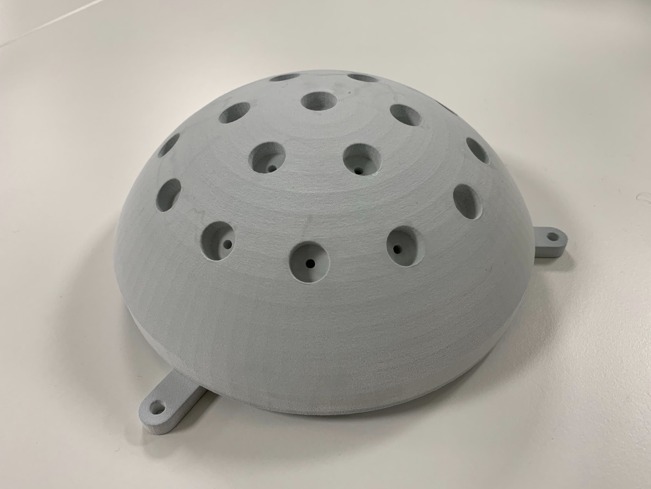& Construction

Integrated BIM tools, including Revit, AutoCAD, and Civil 3D
& Manufacturing

Professional CAD/CAM tools built on Inventor and AutoCAD
3 min read

When many people hear “coral reef,” they picture a rainbow array of creatures coexisting on the ocean floor, snorkeling on vacation, and perhaps even the ever-optimistic Finding Nemo. However, the stark reality is that because of climate change, many of the Earth’s reefs are starting to look more like uninhabited ghost towns due to a process called coral bleaching. Coral bleaching occurs when warming ocean temperatures affect a coral’s biology, causing it to go into a high state of stress and turn white, eventually dying altogether.

Sure, this monochrome display has its own unique, spooky beauty to it, but it certainly isn’t healthy for our planet. “Coral reefs are incredibly biodiverse and important ecologically,” explains Taryn Foster, Founder of Coral Maker. “Their structure also protects our coastlines, providing a barrier to storms and coastal erosion.”
Coral Maker is an Australian company that is taking a new, accelerated approach to restoring coral reefs. Foster, a coral biologist and avid diver, began to think about how she could use her research background to actively restore reefs when she started to connect the dots between her scientific experience and her family business. Her family works in the masonry manufacturing industry, and they own machinery that makes limestone blocks and other products for the construction industry. Then came the lightbulb moment: what if these machines could be used to rapidly make safe skeletons for corals to inhabit?

Through a Fulbright Fellowship at the California Academy of Sciences, Foster moved to San Francisco. She then applied to the Autodesk Technology Center’s residency program at Pier 9 in San Francisco in hopes that she could pursue this idea further. Once accepted, Foster hit the ground running, working with a team of Autodesk support members through the Autodesk Foundation from various backgrounds like robotics, manufacturing, and architecture.

The team designed and modeled the actual coral component in Fusion 360. “We’re working across four vastly different time zones, so Fusion 360’s cloud platform has enabled us to collaborate on the same designs and access the same data,” explains Robert Bowerman, Technical Consultant at Autodesk. “A lot of the work we’ve done has been making conceptual models, 3D printing prototypes and making videos so that Taryn can simply go out and tell people about this problem and the solutions that we’re coming out with.”
The typical coral restoration process involves cutting a little piece of live coral from an existing colony, then allowing that piece to grow its own skeleton and eventually grow into a bigger colony. The issue with this process is time—coral naturally grows very slowly (think 3-10 years before a piece grows its own adult-sized skeleton). In order to speed up the process, Coral Maker provides these tiny coral pieces with premade calcium carbonate skeletons. Once the skeleton CAD was complete, the team employed 3D printing to quickly create prototypes before manufacturing. “To actually make a real impact, you need to be planting millions of corals each year,” explains Bowerman. And that’s exactly what Coral Maker’s process is capable of doing through a mixture of additive and traditional manufacturing techniques.

One of the most interesting aspects of Coral Maker’s process is that the Foster family’s machinery is pretty standard—it’s a traditional brick making machine that is available all around the world. This means that, unlike previous processes, Coral Maker’s process can be deployed anywhere facing coral bleaching, such as the Philippines or Indonesia. “We really considered how we could apply traditional manufacturing techniques or automation to try and achieve that scale,” says Bowerman. “My input has been around designing the product so that it’s suitable for the process but also giving advice on how we can design the tooling to actually make this product using the masonry machine machine. I tried to apply what I know from industries that do achieve scale, like the automotive industry, and apply it to this problem that has never been solved before.”

What’s next for Coral Maker? They’re currently working on a robotic system that will automate the process of planting live corals in the skeletons. They’re hoping other parts of the industry will be able to scale up as well. “Our next bottlenecks are going to be around scaling the supply of live coral, as well as scaling deployment to the reef,” Foster notes. “So there are other problems to solve, but this is about solving one problem that will make it possible for other parts of the industry to scale what they’re doing.”
Keep up with Coral Maker’s journey over on their website or social media, and download Fusion 360 today to see how it can improve your workflow.

By clicking subscribe, I agree to receive the Fusion newsletter and acknowledge the Autodesk Privacy Statement.
Success!
May we collect and use your data?
Learn more about the Third Party Services we use and our Privacy Statement.May we collect and use your data to tailor your experience?
Explore the benefits of a customized experience by managing your privacy settings for this site or visit our Privacy Statement to learn more about your options.